| dc.contributor.author | Copen, William A. | en_US |
| dc.contributor.author | Morais, Livia T. | en_US |
| dc.contributor.author | Wu, Ona | en_US |
| dc.contributor.author | Schwamm, Lee H. | en_US |
| dc.contributor.author | Schaefer, Pamela W. | en_US |
| dc.contributor.author | González, R. Gilberto | en_US |
| dc.contributor.author | Yoo, Albert J. | en_US |
| dc.date.accessioned | 2015-08-03T14:02:16Z | |
| dc.date.issued | 2015 | en_US |
| dc.identifier.citation | Copen, William A., Livia T. Morais, Ona Wu, Lee H. Schwamm, Pamela W. Schaefer, R. Gilberto González, and Albert J. Yoo. 2015. “In Acute Stroke, Can CT Perfusion-Derived Cerebral Blood Volume Maps Substitute for Diffusion-Weighted Imaging in Identifying the Ischemic Core?” PLoS ONE 10 (7): e0133566. doi:10.1371/journal.pone.0133566. http://dx.doi.org/10.1371/journal.pone.0133566. | en |
| dc.identifier.issn | 1932-6203 | en |
| dc.identifier.uri | http://nrs.harvard.edu/urn-3:HUL.InstRepos:17820860 | |
| dc.description.abstract | Background and Purpose In the treatment of patients with suspected acute ischemic stroke, increasing evidence suggests the importance of measuring the volume of the irreversibly injured “ischemic core.” The gold standard method for doing this in the clinical setting is diffusion-weighted magnetic resonance imaging (DWI), but many authors suggest that maps of regional cerebral blood volume (CBV) derived from computed tomography perfusion imaging (CTP) can substitute for DWI. We sought to determine whether DWI and CTP-derived CBV maps are equivalent in measuring core volume. Methods: 58 patients with suspected stroke underwent CTP and DWI within 6 hours of symptom onset. We measured low-CBV lesion volumes using three methods: “objective absolute,” i.e. the volume of tissue with CBV below each of six published absolute thresholds (0.9–2.5 mL/100 g), “objective relative,” whose six thresholds (51%-60%) were fractions of mean contralateral CBV, and “subjective,” in which two radiologists (R1, R2) outlined lesions subjectively. We assessed the sensitivity and specificity of each method, threshold, and radiologist in detecting infarction, and the degree to which each over- or underestimated the DWI core volume. Additionally, in the subset of 32 patients for whom follow-up CT or MRI was available, we measured the proportion of CBV- or DWI-defined core lesions that exceeded the follow-up infarct volume, and the maximum amount by which this occurred. Results: DWI was positive in 72% (42/58) of patients. CBV maps’ sensitivity/specificity in identifying DWI-positive patients were 100%/0% for both objective methods with all thresholds, 43%/94% for R1, and 83%/44% for R2. Mean core overestimation was 156–699 mL for objective absolute thresholds, and 127–200 mL for objective relative thresholds. For R1 and R2, respectively, mean±SD subjective overestimation were -11±26 mL and -11±23 mL, but subjective volumes differed from DWI volumes by up to 117 and 124 mL in individual patients. Inter-rater agreement regarding the presence of infarction on CBV maps was poor (kappa = 0.21). Core lesions defined by the six objective absolute CBV thresholds exceeded follow-up infarct volumes for 81%-100% of patients, by up to 430–1002 mL. Core estimates produced by objective relative thresholds exceeded follow-up volumes in 91% of patients, by up to 210-280 mL. Subjective lesions defined by R1 and R2 exceeded follow-up volumes in 18% and 26% of cases, by up to 71 and 15 mL, respectively. Only 1 of 23 DWI lesions (4%) exceeded final infarct volume, by 3 mL. Conclusion: CTP-derived CBV maps cannot reliably substitute for DWI in measuring core volume, or even establish which patients have DWI lesions. | en |
| dc.language.iso | en_US | en |
| dc.publisher | Public Library of Science | en |
| dc.relation.isversionof | doi:10.1371/journal.pone.0133566 | en |
| dc.relation.hasversion | http://www.ncbi.nlm.nih.gov/pmc/articles/PMC4508041/pdf/ | en |
| dash.license | LAA | en_US |
| dc.title | In Acute Stroke, Can CT Perfusion-Derived Cerebral Blood Volume Maps Substitute for Diffusion-Weighted Imaging in Identifying the Ischemic Core? | en |
| dc.type | Journal Article | en_US |
| dc.description.version | Version of Record | en |
| dc.relation.journal | PLoS ONE | en |
| dash.depositing.author | Copen, William A. | en_US |
| dc.date.available | 2015-08-03T14:02:16Z | |
| dc.identifier.doi | 10.1371/journal.pone.0133566 | * |
| dash.contributor.affiliated | Copen, William | |
| dash.contributor.affiliated | Wu, Ona | |
| dash.contributor.affiliated | Schaefer, Pamela | |
| dash.contributor.affiliated | Schwamm, Lee | |


